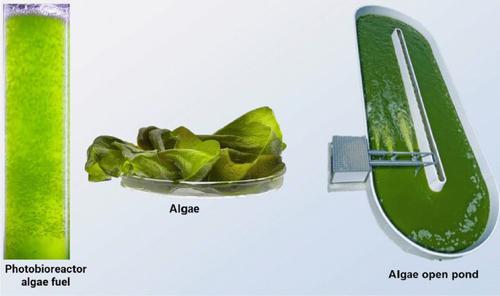Environmental Chemistry Letters ( IF 15.7 ) Pub Date : 2022-06-15 , DOI: 10.1007/s10311-022-01458-1 Asma Sarwer , Seham M. Hamed , Ahmed I. Osman , Farrukh Jamil , Ala’a H. Al-Muhtaseb , Nawaf S. Alhajeri , David W. Rooney

|
The world is experiencing an energy crisis and environmental issues due to the depletion of fossil fuels and the continuous increase in carbon dioxide concentrations. Microalgal biofuels are produced using sunlight, water, and simple salt minerals. Their high growth rate, photosynthesis, and carbon dioxide sequestration capacity make them one of the most important biorefinery platforms. Furthermore, microalgae's ability to alter their metabolism in response to environmental stresses to produce relatively high levels of high-value compounds makes them a promising alternative to fossil fuels. As a result, microalgae can significantly contribute to long-term solutions to critical global issues such as the energy crisis and climate change. The environmental benefits of algal biofuel have been demonstrated by significant reductions in carbon dioxide, nitrogen oxide, and sulfur oxide emissions. Microalgae-derived biomass has the potential to generate a wide range of commercially important high-value compounds, novel materials, and feedstock for a variety of industries, including cosmetics, food, and feed. This review evaluates the potential of using microalgal biomass to produce a variety of bioenergy carriers, including biodiesel from stored lipids, alcohols from reserved carbohydrate fermentation, and hydrogen, syngas, methane, biochar and bio-oils via anaerobic digestion, pyrolysis, and gasification. Furthermore, the potential use of microalgal biomass in carbon sequestration routes as an atmospheric carbon removal approach is being evaluated. The cost of algal biofuel production is primarily determined by culturing (77%), harvesting (12%), and lipid extraction (7.9%). As a result, the choice of microalgal species and cultivation mode (autotrophic, heterotrophic, and mixotrophic) are important factors in controlling biomass and bioenergy production, as well as fuel properties. The simultaneous production of microalgal biomass in agricultural, municipal, or industrial wastewater is a low-cost option that could significantly reduce economic and environmental costs while also providing a valuable remediation service. Microalgae have also been proposed as a viable candidate for carbon dioxide capture from the atmosphere or an industrial point source. Microalgae can sequester 1.3 kg of carbon dioxide to produce 1 kg of biomass. Using potent microalgal strains in efficient design bioreactors for carbon dioxide sequestration is thus a challenge. Microalgae can theoretically use up to 9% of light energy to capture and convert 513 tons of carbon dioxide into 280 tons of dry biomass per hectare per year in open and closed cultures. Using an integrated microalgal bio-refinery to recover high-value-added products could reduce waste and create efficient biomass processing into bioenergy. To design an efficient atmospheric carbon removal system, algal biomass cultivation should be coupled with thermochemical technologies, such as pyrolysis.
中文翻译:

用于生物燃料生产和碳封存的藻类生物质价值:综述
由于化石燃料的枯竭和二氧化碳浓度的持续增加,世界正在经历能源危机和环境问题。微藻生物燃料是使用阳光、水和简单的盐矿物质生产的。它们的高生长速率、光合作用和二氧化碳封存能力使它们成为最重要的生物精炼平台之一。此外,微藻能够根据环境压力改变其新陈代谢以产生相对高水平的高价值化合物,这使它们成为化石燃料的有希望的替代品。因此,微藻可以为能源危机和气候变化等关键全球问题的长期解决方案做出重大贡献。藻类生物燃料的环境效益已通过显着减少二氧化碳、氮氧化物和硫氧化物的排放得到证明。微藻衍生的生物质有可能为包括化妆品、食品和饲料在内的各种行业产生广泛的具有商业重要性的高价值化合物、新型材料和原料。本综述评估了使用微藻生物质生产各种生物能源载体的潜力,包括来自储存脂质的生物柴油、来自储备碳水化合物发酵的醇,以及通过厌氧消化、热解和气化的氢气、合成气、甲烷、生物炭和生物油。此外,正在评估微藻生物质在碳封存路线中作为大气碳去除方法的潜在用途。藻类生物燃料生产的成本主要取决于培养(77%)、收获(12%)和脂质提取(7.9%)。因此,微藻种类和培养模式(自养、异养和混合养)的选择是控制生物质和生物能源生产以及燃料特性的重要因素。在农业、市政或工业废水中同时生产微藻生物质是一种低成本的选择,可以显着降低经济和环境成本,同时还提供有价值的修复服务。微藻也被提议作为从大气或工业点源中捕获二氧化碳的可行候选者。微藻可以隔离 1.3 公斤的二氧化碳以产生 1 公斤的生物质。因此,在用于二氧化碳封存的高效设计生物反应器中使用有效的微藻菌株是一项挑战。理论上,在开放式和封闭式培养中,微藻每年每公顷可以使用高达 9% 的光能来捕获并将 513 吨二氧化碳转化为 280 吨干生物量。使用集成的微藻生物精炼厂来回收高附加值产品可以减少浪费,并将高效的生物质加工成生物能源。为了设计一个高效的大气碳去除系统,藻类生物质培养应与热化学技术相结合,如热解。使用集成的微藻生物精炼厂来回收高附加值产品可以减少浪费,并将高效的生物质加工成生物能源。为了设计一个高效的大气碳去除系统,藻类生物质培养应与热化学技术相结合,如热解。使用集成的微藻生物精炼厂来回收高附加值产品可以减少浪费,并将高效的生物质加工成生物能源。为了设计一个高效的大气碳去除系统,藻类生物质培养应与热化学技术相结合,如热解。



























 京公网安备 11010802027423号
京公网安备 11010802027423号